Building Control could soon be dealing with a whole new ball game if technological advances using drones and robotic bulldozers continue at their current rate. Drones, or unmanned aerial vehicles (UAVs) are already being used to monitor construction projects in the US and Japan from high above. So will the future of Building Control be interacting with robotic workers and monitoring sites through the eyes of AI?

Eyes in the Sky
As part of innovative new technologies being deployed in construction, US start-up business Skycatch is already using drones on some high-profile building projects. Drones can provide useful aerial views of a site, while monitoring progress and spotting any problems that need to be addressed. These could be design changes, or needing to order more construction materials. Everything can be automated and controlled without anyone having to set foot on the site and with digital imagery and cameras, the visual quality of such reports are as good as being present in person.
A Close-up Look
Drones are also being utilised for carrying out building inspections – either for annual check-ups on a building’s condition, or assessing damage caused by age or bad weather. Remedial and renovation work can now be assessed at ground level and a course of action formulated with ease. Information collected by the drone, including dimensions, can also be used to create 3-D maps and models. With limited access to dangerous places such as towers or roofs, what once might have taken hours, with costly scaffolding, lifts and ladders, can now be carried out in a matter of minutes by an experienced controller remotely guiding the aerial camera drone. Companies offering external building inspections via drone are proving particularly useful in areas such as cities, where access isn’t always easy, even at ground level.
Auto-guided Machines
Japanese construction machinery company Komatsu is using drones to guide automated bulldozers. Using 3-D mapping techniques and customised, automated machinery, work can be carried out safely with little chance of injury, loss of time to illness or, to an extent, regardless of inclement weather conditions. Komatsu’s Intelligent Machine Technology (iMT) was unveiled in 2013 and allows lower-skilled workers to carry out, through remote operation, a higher-skilled task. Komatsu’s SmartConstruction business combines its driverless, automated earth-moving equipment to drone-guided technology to make a fully-automated construction process. In Japan, robotic working perhaps offers a solution to the problem of an ageing workforce.
Aerial Inspections
Looking into the future, new technologies such as drones may seem like ‘pie in the sky’ in terms of practical use. But Building Control making greater use of drones to monitor construction sites is an exciting prospect. With technologies such as iApply – the UK’s first combined Planning and Building Control portal – improving interaction, it’s only a matter of time before there’s even more demand for digital information sharing across multiple platforms. If fluidity and interconnectivity are key, then site visits and inspections may well soon be carried out by drones and linked back to local authority computer systems many miles away. Drones could be used to monitor ongoing work, map progress and quality, and everything would be recorded and available for viewing and discussion afterwards. If technology can be made usable in this everyday way, then the sky truly is the limit.
For further information on iApply, please visit www.iapply.co.uk or watch the introductory video highlighting just some of the major advantages of investing in the service http://bit.ly/2duwKyo













